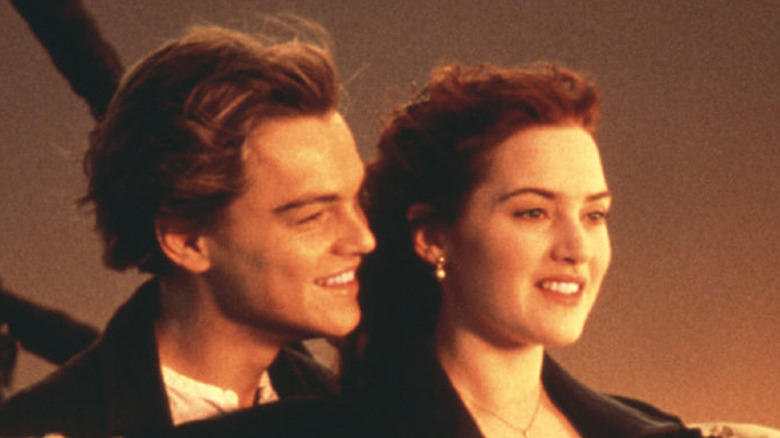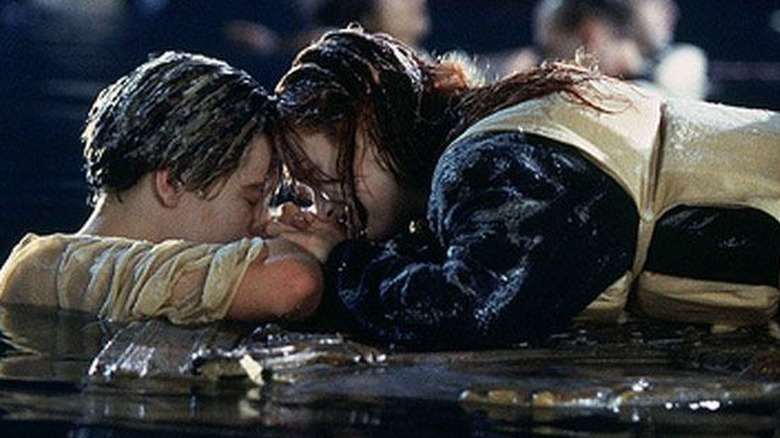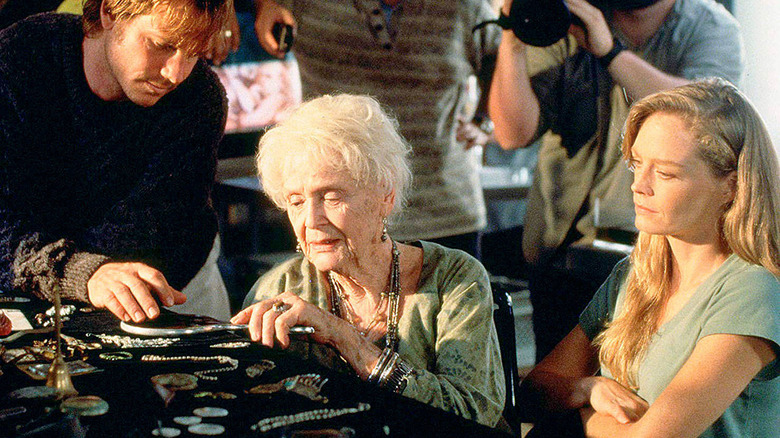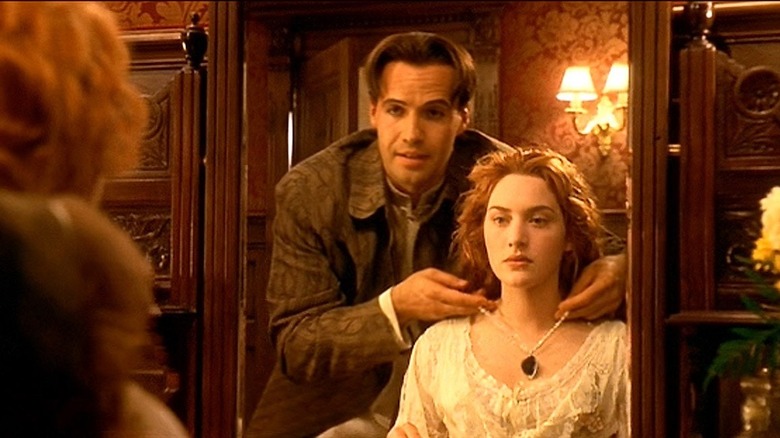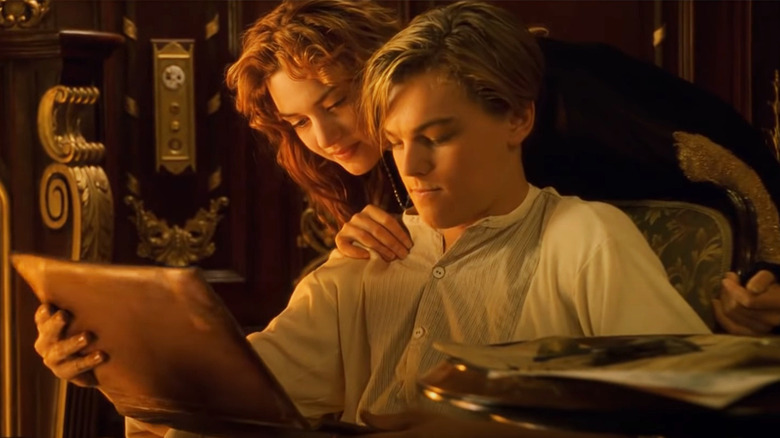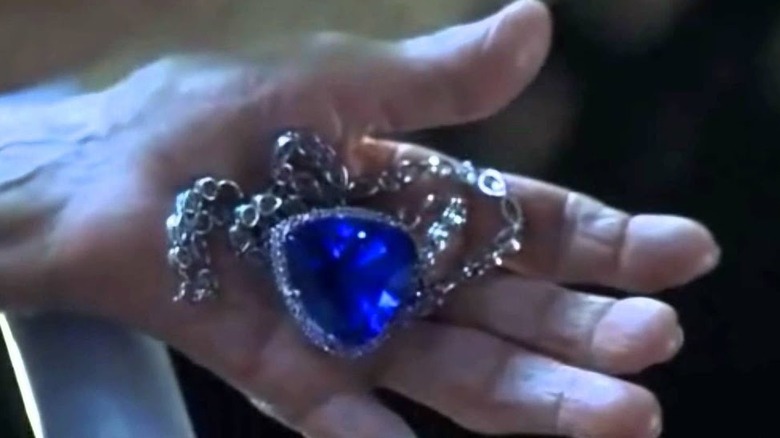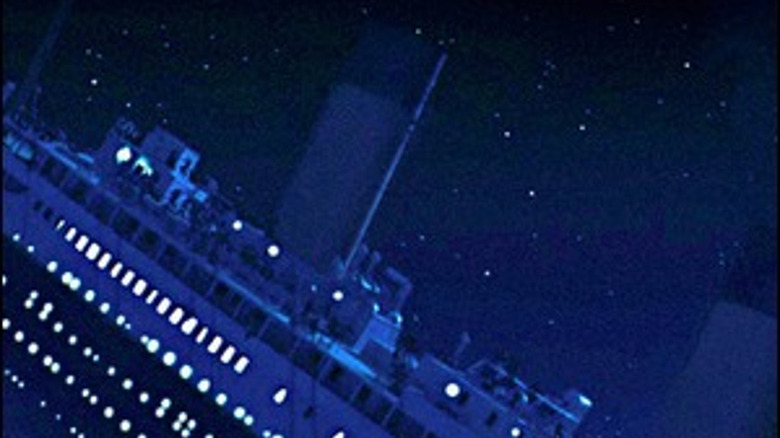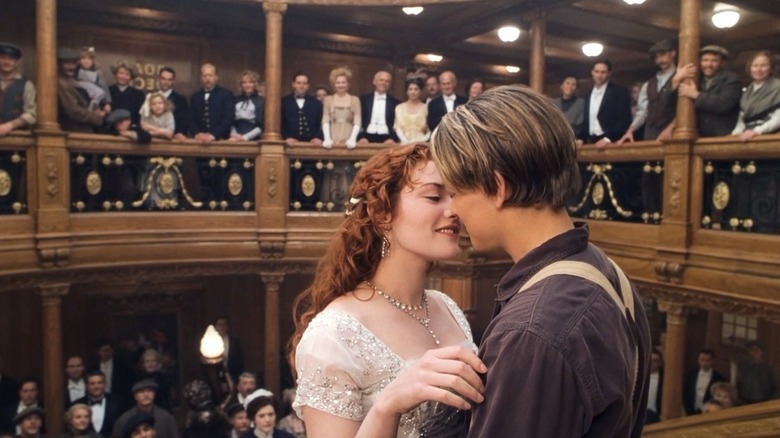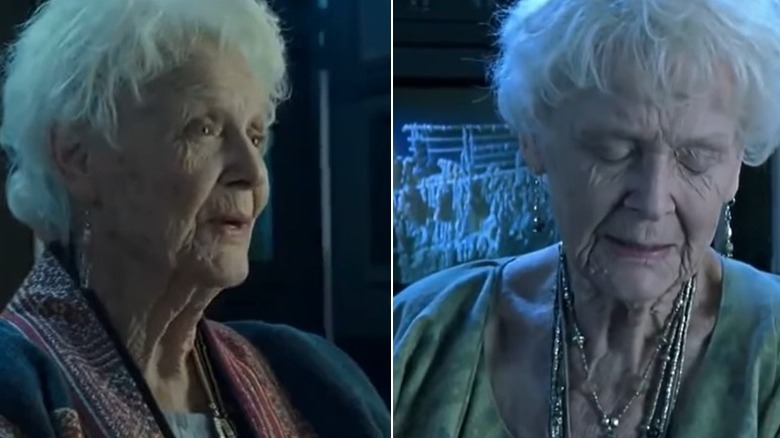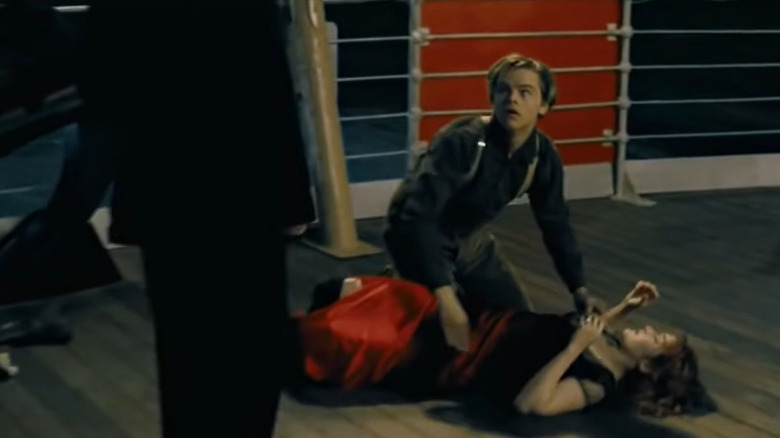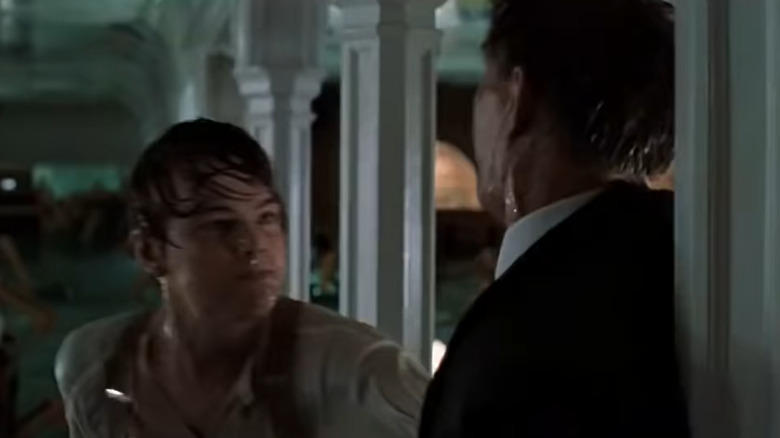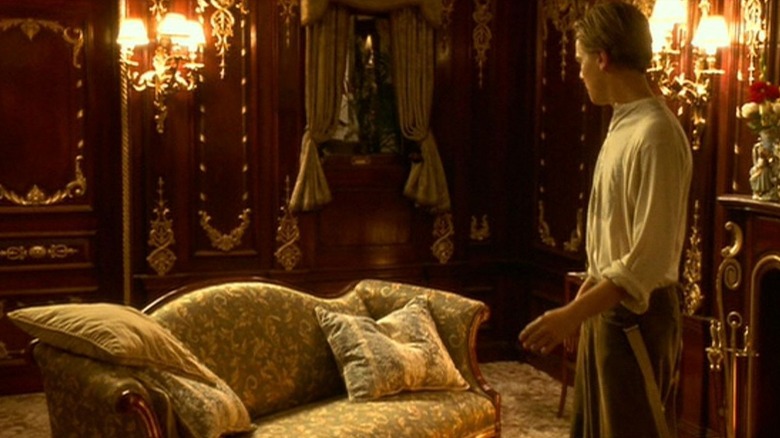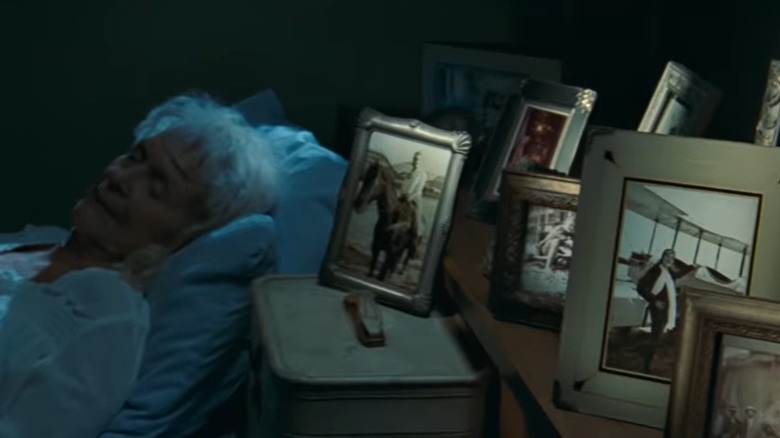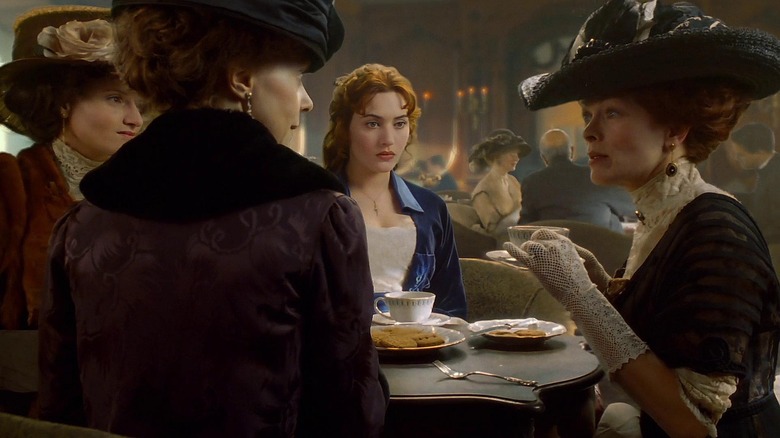Titanic Scenes That Make No Sense
Believe it or not, there was a time, only a couple of decades ago, when the box office was not absolutely dominated by superhero movies and sequels or reboots of established franchises. Before the MCU, "Harry Potter," and others completely changed the game, you could often find standalone movies ruling the roost.
Few of those movies ruled the roost as completely as "Titanic" did in 1997. A passion project for filmmaker James Cameron, the movie was a fictional retelling of one of the most famous maritime tragedies of all time. "Titanic" gave a personal bent to the tragedy through its fictional leads Jack and Rose, played by Leonardo DiCaprio and Kate Winslet in their stardom-defining roles, with an excellent supporting cast of actors at the top of their game.
"Titanic" rewrote the rules of what it meant to be a successful film, becoming the highest-grossing feature of all time and holding on to that record for more than a decade before being unseated by another Cameron flick, "Avatar." The movie also picked up 11 Academy Awards and became an enduring part of the pop culture zeitgeist. Despite its many achievements, "Titanic" was not a perfect film by any means. Here are certain scenes that have left audiences scratching their heads for the last 25 years.
That much-discussed floating wooden panel
Let's get this one out of the way at the start. Possibly the most heavily discussed aspect of "Titanic," this scene has become the subject of so much controversy even James Cameron had to weigh in on it.
Near the end of the movie, Jack and Rose are left to fend for themselves in the freezing waters of the Atlantic ocean. Driven to desperation, the only option is for Rose to clamber onto a floating wooden door from the Titanic. Jack holds on to its edge even as most of his torso is submerged underwater. While Rose, relatively dry in an overcoat and a life preserver, has just enough body heat to keep herself conscious, Jack's body freezes and he sinks to the bottom of the ocean in front of Rose's eyes. But why did Jack not clamber onto the pretty wide panel of wood and lie next to Rose, out of the water?
To be fair, when the panel threatens to go under the water from their combined weight, Jack opts to keep Rose safe on top of it at the expense of his own life. It's also clear that he can't leave her to find his own piece of flotsam without risking some other survivor trying to push her off and claim the board for themselves. But shouldn't Rose have insisted he try a few more times before resigning himself to death?
The MythBusters waded into the debate and determined that, while it would have been tricky to balance both Jack and Rose on top of the panel without tipping it over, the feat could have been managed with some minor creative engineering using a lifejacket. (It may also depend on what type of wood the door was made of).
How does Rose know the complete story?
"Titanic" begins in the present time with a crew of deep-sea explorers extracting valuable objects from the wreck of the ocean liner. One of the objects is a safe that carries a drawing of a woman identified as Rose Dawson Calvert, whom the explorers hope can provide them with a lead about the famous "Heart of the Ocean" diamond said to be lost among the wreckage of the Titanic.
Rose is tracked down and brought to the ship containing the explorers and the safe with the drawing. At this point, Rose is more than 100 years old. She's still able to provide a clear and thrilling account of what happened between herself and Jack, as well as the other people who were aboard the Titanic on the fateful day of the sinking.
But how did Rose know the parts of the story that she was not personally present for? As the older Rose narrates the events, we see scenes that the younger Rose had no business knowing about, like what went on among the ship's crew when the Titanic hit the iceberg or the people who were locked in their own separate struggle to survive the shipwreck. There are key plot points she's not present for involving Jack or her fiancé Caledon (Billy Zane). Unless either of them stopped off-camera as the ship was sinking to fill her in, there's no way she could have known some of these details. A lot of the story told by Rose appears to be highly embroidered yarn-spinning on her part rather than a factual statement of the past—that, or Cameron's just taking some illogical liberties for the sake of evocative storytelling.
Not keeping her account straight
The treasure hunters bring the elderly Rose onto their ship to examine the excavated remains from the Titanic so she can fill in gaps in their understanding of the maritime tragedy. As someone who had lived through the ordeal, Rose can be relied upon to give a fairly accurate account of the incident.
Except, not really. Keep in mind Rose is more than 100 years old at the time, with all the lapses in memory that accompany such advanced age. Some studies suggest that people have distorted recollections of traumatic events. Rose also makes no attempt to be objective in her retelling. She paints herself and her forbidden lover as the heroes of the narrative, with other people in the story being either the villains, comic relief, or background characters. Some fans even argue that Cal, Rose's spurned husband-to-be, is actually the good guy.
The fact that Rose's account can't be considered 100% accurate is made clear when she mentions that she only wore the "Heart of the Ocean" diamond once in her life. But in the flashbacks, we see Rose wear the diamond twice: once when Cal places it around her neck, and another time when she poses for Jack. It's a pretty minor inconsistency—maybe she just meant only once of her own volition—but it does make you wonder what other parts of Rose's story might have been embellished or made up, deliberately or otherwise. Was she ever really able to stand on her tippy-toes without wearing sturdy ballet shoes?
How did the drawing even survive?
What kickstarts the events of "Titanic" is a safe retrieved from the bottom of the ocean inside the wreck of the ship. After the safe is opened, the researchers discover a drawing of a nude young woman wearing the Heart of the Ocean around her neck. Thanks to the drawing, the researchers are able to track down Rose and bring her to see it for herself.
Upon arriving on the ship and seeing the old drawing, the elderly Rose is swept away by a wave of memories. The drawing of her young self becomes a painful reminder of Rose's past, particularly Jack Dawson, the man who made the drawing and sacrificed his life to keep her safe.
But how did the drawing stay intact and legible enough to trigger those events in the first place? The safe is completely swamped with seawater when it is first opened. That means the charcoal drawing of Rose endured several decades of floating around in water and somehow did not completely disintegrate in the process. The strongest wood and iron objects turn unrecognizable when left under the bottom of the ocean for a few years. What kind of magic paper and charcoal was Jack using to give his drawings such a long life?
Why toss the Heart of the Ocean?
While "Titanic" is best remembered as a tender love story, it starts with more materialistic goals. Bill Paxton plays Brock Lovett, an underwater explorer and treasure hunter whose main purpose in investigating the ruins of the Titanic is to find the mythical "Heart of the Ocean," a giant diamond worth a lot of money.
Brock listens so patiently to Rose's story about her time aboard the doomed ship chiefly because he's hoping to get clues from the narrative that will help him find the diamond. That hope turns out to be in vain, as Rose tells them nothing to aid his search. At the end of the film, not only is Rose revealed to have been in possession of the diamond the whole time, but she chooses to toss it into the ocean. And to that we say... what the hell?
Rose has many painful memories connected to the diamond, but they clearly weren't painful enough to make her throw it away for the many decades she had it in her possession since the Titanic sank. But now, with only a short amount of time left in the world, Rose decides to toss the diamond. How about giving it to her granddaughter Lizzy (Suzy Amis), who takes such good care of Rose, and who surely wouldn't mind owning a diamond worth millions? Or to the explorers who searched for the diamond for so many years? Or to one of the multiple Titanic museums around the world? Any charitable organization would have happily accepted the donation.
We get that the action symbolizes Rose finally letting go of the terrible past. We also get that it's a choice consistent with her disdain for money in favor of what really matters in life: love. Still, that's a pretty freakin' expensive symbol. Maybe the selfishness we often see the younger Rose exhibit is still a major part of her personality in her final days. At least this final gesture isn't as jarring as the alternate ending for "Titanic" that we almost got.
The stars do not line up
Regular moviegoers love to pick apart popular films, especially on the internet. Most of the time, the filmmakers are able to brush their criticisms aside. But sometimes those critics are notable people in their own right, in which case the filmmaker might actually change their entire movie to appease the critic.
That is what happened when noted astrophysicist Neil deGrasse Tyson weighed in on a scene from "Titanic" that was bugging him. Since his expertise was in the field of star-gazing, Tyson observed the scenes in the movie where the shipwrecked passengers are floating in the ocean at night and found them lacking. Specifically, Tyson declared that the alignment of the stars in the scenes was not consistent with the actual position of the stars at that time in real life.
"Neil deGrasse Tyson sent me quite a snarky e-mail," James Cameron revealed to Discover (via Washington Post). "Saying that, at that time of year, in that position in the Atlantic in 1912, when Rose is lying on the piece of driftwood and staring up at the stars, that is not the star field she would have seen." Ever the perfectionist, Cameron hauled the movie back onto the editing table to change the location of the stars according to Tyson's notes.
The missing husband
While "Titanic" is a story about a real-life tragedy, the movie focuses on the fictional characters Jack and Rose (though it may have been loosely inspired by a true onboard romance). In the great tradition of forbidden lovers held apart by a cruel world and a cruel fate, Jack and Rose are only able to enjoy a few days together before the relationship is torn apart for good.
Jack gives up his life so that Rose may survive. And she does. For a really long time. After getting rescued from the wreck of the Titanic, Rose adopts Jack's surname and goes on to live a long and fulfilling life. She becomes a successful actress, rides horses, and experiences all the adventures Jack wanted her to have. At some point, Rose also marries "some guy named Calvert" and has children with him. Those children, in turn, give her grandchildren.
Rose never forgets about Jack and imagines he'll be waiting for her in the afterlife after she passes away. But what about Calvert? Seems like the guy who loved and supported Rose through years and decades, gave her children, and helped her accomplish all her dreams has as much a right to her love in the afterlife as Jack. It's a cruel move on Rose's part to cut Calvert out of her happy afterlife so she could get back together with some dude she knew for less than a week many decades ago.
The break in the narrative
While "Titanic" is a pretty long movie, it was originally supposed to be longer still. Several significant scenes were edited out of the film to make it shorter, which also made it less comprehensible. That's what happens with some of the scenes of the older Rose aboard the ship containing wreckage from the Titanic.
The crew of the ship listens to Rose's story with great attention as she narrates her forbidden love affair with Jack aboard the Titanic. The scenes make it seem like Rose told her story all in one sitting. At one point, one of the explorers remarks, "We never found anything on Jack. There's no record of him at all." But if the whole story was told at once, when did the explorers have time to do a background check?
The answer is in one of the scenes edited out of the movie. After getting halfway through her story, Rose gets offended by a joke one of the explorers makes about her story and retires to rest. While she sleeps, the ship's crew works on digging through the wreck of the Titanic again and trying to find real-life evidence to corroborate Rose's story. Then she wakes up and sits down once again to finish the rest of her story. The downtime in between telling the story can be deduced by the fact that Rose has changed her clothes in the middle of her narration.
Why did Jack not clarify his position?
The meet-cute between Jack and Rose at the start of "Titanic" is as messy as you can expect. Feeling suffocated by her life and the prospect of marrying a man she does not love, Rose decides to end her life by jumping off the ship into the freezing waters below. But her attempt is spotted by Jack.
With some coaxing and some pretty scary descriptions of the ocean water that Rose was planning to jump into, Jack gets her to change her mind. Just as he's helping her off the ship's railing, Rose's dress causes her to slip. With great difficulty, Jack pulls Rose back on board. When the ship's guards come to find them, they assume Jack was trying to force himself on Rose.
The guards are ready to beat the crap out of Jack when Rose stops them and explains what happened. But why did Jack not speak up for himself? He did a good deed, and the penalty for the very serious crime the guards thought he committed might have gotten him thrown overboard then and there. He's also portrayed as a plucky, scrappy, quick-thinking street lad; even if he wanted to chivalrously spare Rose the potential embarrassment of the truth, he surely could have come up with a clever lie. There was little motivation for Jack to stand off to the side with his hands in his pockets and let the guards continue thinking of him as a rapist.
The bloody bodyguard
Like any rich villain, Cal prefers to let others do his dirty work for him. Specifically, his bodyguard Lovejoy (David Warner) is in charge of keeping an eye on Jack to make sure he doesn't get too close to Rose. He later frames Jack for theft by putting the Heart of the Ocean in his pocket.
When the Titanic begins to sink, Lovejoy is at Cal's side when the latter loses his mind and elects to chase Jack and Rose with a gun instead of getting to safety. A few scenes later, Cal and Lovejoy are shown to be separated. Lovejoy also has a bloodied face. The reason behind that isn't clear to the audience due to a scene in the middle getting cut.
In the deleted scene, Cal gives Lovejoy the gun and allows him to go after Jack and Rose alone to get the diamond back. Lovejoy takes up the mission and chases Jack and Rose into a dining area. A spirited fight ensues in which Jack manages to beat Lovejoy, bloodying his face in the process. The scene also leads directly into the next story point, where Jack and Rose escape into the ship's lower decks to get away from Lovejoy.
Rose was not very careful
In one of the most famous scenes from "Titanic," Rose invites Jack to her room so he can sketch her in the nude while wearing only the Heart of the Ocean diamond. At first nonplussed, Jack speedily puts his doubts aside and happily sketches Rose.
But the location Rose chooses is a puzzling one. She allows Jack to come to her room, where Cal or her mother could walk in at any moment and see her in her birthday suit getting drawn by the man they view as a disreputable rogue. In fact, Rose keeps the door to her room open, as if she actually hopes someone will walk in to witness her act of rebellion.
But if Rose is so cool with getting caught, what's the whole song and dance later on to find a private place to get intimate with Jack? The two go out of their way to find a car in storage so they won't be interrupted. Would they not have been much more comfortable in Rose's room, where the intercourse would've taken less time than however long it took for Jack to draw her?
Who were the portraits for?
While Jack had an important part to play in the proceedings, "Titanic" was really Rose's story. She was the young girl for whom the ship was a prison in which her mother kept her until her arranged marriage to Cal. The ship also became the source of Rose's liberation after she met and fell in love with the handsome and mysterious Jack Dawson.
Ultimately, while both Jack and the ship were lost, Rose's story went on. As we see in the film's final moments through a series of portraits kept on the older Rose's nightstand, she had lived a long and fulfilling life, just as she promised Jack she would. From flying an airplane and riding horses to becoming an actress and starting a family, the photos were a testament to a live well-lived. But... why bring those photos with her at all?
Rose's arrival on the ship exploring the Titanic was a last-minute arrangement that should have necessitated only packing essential stuff that would be needed for a couple of days. Even if you're traveling for longer than that, bringing treasured family photos seems like an odd choice. It seems unlikely that Rose's granddaughter would be cool with lugging around a bunch of portraits with solid, heavy frames just so her grandma could fall asleep next to them. Between this and the whole "tossing the diamond into the ocean" thing, it's starting to look like Rose wasn't a very considerate grandmother.
Rose just leaves her mom?
Rose's relationship with her mother Ruth (Frances Fisher) is far from a happy one. It's Ruth who pressures Rose to marry the wealthy Cal so he can elevate the family's social standing. Although Ruth knows Cal is a difficult man to love and Rose positively loathes him, she drags her daughter into the marriage, thinking she knows what's best for her.
In the end, Ruth manages to survive the sinking of the Titanic, just like her daughter. But the two get separated. We see Ruth looking for Rose after their rescue, but Rose deliberately hides because she doesn't want anything to do with her mother. So what happens to Ruth after that? We don't know, because Rose makes no mention of her. That seems like a pretty callous attitude to adopt towards your mom, especially after you've both survived such a horrendous event.
Keep in mind that Ruth is shown to really care for Rose. Sure, the whole "you must marry a guy so he gives us money" schtick seems suspect by today's standards, but what Ruth expects of Rose was pretty much the norm back then and something Ruth had also done in her own marriage. As it is, without Rose or Cal to support her in her advanced age, it is likely Ruth died alone, poverty-stricken and broken-hearted, while her daughter went on to have a large family and what looks to be an upper-class life filled with horse-riding and acting. If they ever reunited down the line, it's not mentioned. In a certain light, Rose seems as cold-hearted as the iceberg that sunk the Titanic.
